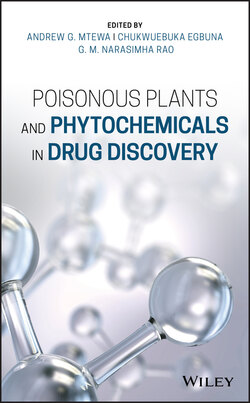Читать книгу Poisonous Plants and Phytochemicals in Drug Discovery - Группа авторов - Страница 21
1.5 Plant Fishing Poisons/Piscicides/Ichthyotoxins
ОглавлениеPiscicidal/ichthyotoxic plants are widely distributed throughout the world [38]. The use of plant toxins in fishing was widespread in tropical Africa but is now restricted to remote parts of the continent because it is largely banned [39]. In tropical Africa alone, Neuwinger [39] documented 258 fishing poisons/piscicidal/ichthyotoxic plants from 25 years of field research and concluded that 10–20% of fishing poisons are yet to be discovered. Ten years later, Neuwinger [40] documented an additional 325 fish‐poisoning plants.
Using plant extracts or toxins for fishing involves pounding the plant material and throwing it into shallow pools or sections of small rivers that have been dammed to give relatively still water. The fish are stupefied and, after a short while, float to the surface of the water. They are easily picked up by hand and then eaten without any untoward effects on the health of the consumers. Women have traditionally carried out this activity in Africa [39–41].
The main active compounds are saponins, rotenoids, and diterpene esters. They represent the most important and most common constituents in ichthyotoxic plants and are of great interest to scientists [39, 40]. These biologically active compounds have potential as insecticides and many are widely used in traditional medicine and in preparation of arrow poisons [39]. For example, Cissus quadrangularis is used in Nigeria both as a fish poison and as an arrow poison to kill small birds. Many piscicidal plants from Africa are predominantly from the Leguminosae family, followed by the Euphorbiaceae family [39, 40]. Ichthyotoxic compounds have several other biological activities, such as the anticancer and potent antiviral activities of compounds isolated from Dryopteris fragrans [42] and the antibacterial activity of rotenoids against the ulcer‐causing Helicobacter pylori [43].
The most commonly used piscicidal plants in Africa are Tephrosia vogelii, Mundulea sericea, Euphorbia tirucalli, Gnidia kraussiana, Adenia lobata, Balanites aegyptiaca, Swartzia madagascariensis, Neoratanenia mitis, Tetrapleura tetraptera, and Strychnos aculeata [40]. C. quadrangularis is often used in conjunction with other local plant poisons such as B. aegyptiaca and T. vogelii. The mixture of the three toxic plants is more toxic than any one of the poisons used alone [39].
